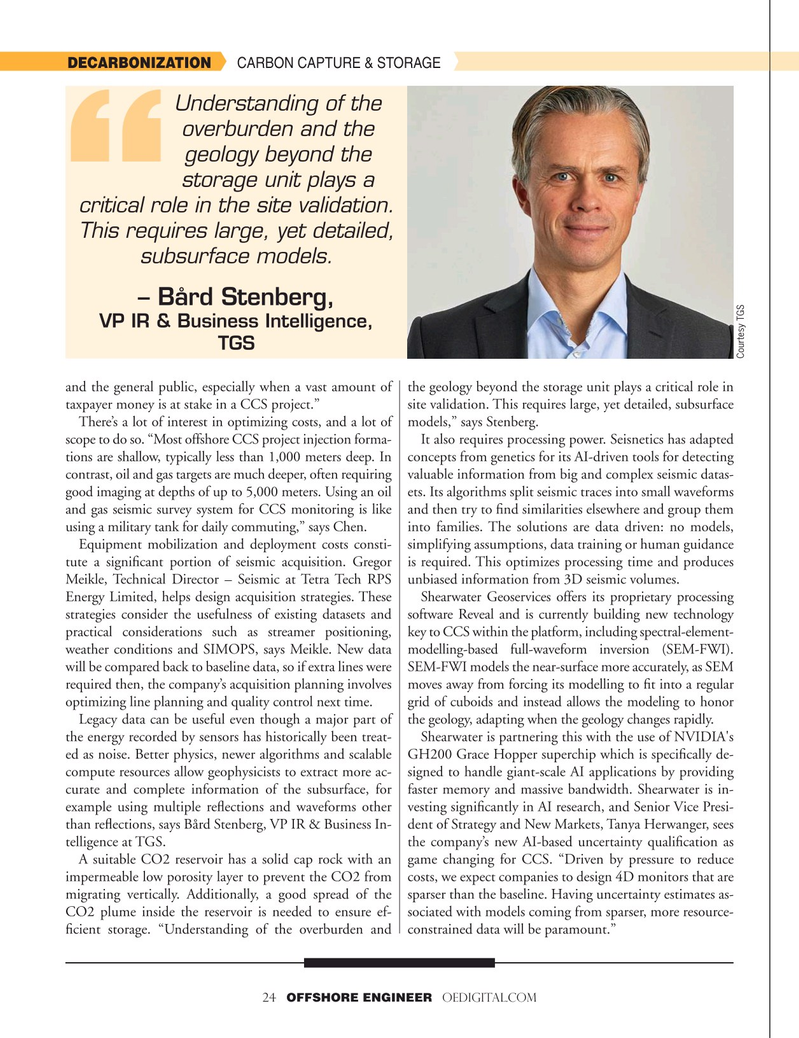
Page 24: of Offshore Engineer Magazine (Jan/Feb 2025)
Read this page in Pdf, Flash or Html5 edition of Jan/Feb 2025 Offshore Engineer Magazine
DECARBONIZATION CARBON CAPTURE & STORAGE
Understanding of the overburden and the geology beyond the storage unit plays a critical role in the site validation.
This requires large, yet detailed, subsurface models. – Bård Stenberg,
VP IR & Business Intelligence,
TGS
Courtesy TGS and the general public, especially when a vast amount of the geology beyond the storage unit plays a critical role in taxpayer money is at stake in a CCS project.” site validation. This requires large, yet detailed, subsurface
There’s a lot of interest in optimizing costs, and a lot of models,” says Stenberg.
scope to do so. “Most offshore CCS project injection forma- It also requires processing power. Seisnetics has adapted tions are shallow, typically less than 1,000 meters deep. In concepts from genetics for its AI-driven tools for detecting contrast, oil and gas targets are much deeper, often requiring valuable information from big and complex seismic datas- good imaging at depths of up to 5,000 meters. Using an oil ets. Its algorithms split seismic traces into small waveforms and gas seismic survey system for CCS monitoring is like and then try to ?nd similarities elsewhere and group them using a military tank for daily commuting,” says Chen. into families. The solutions are data driven: no models,
Equipment mobilization and deployment costs consti- simplifying assumptions, data training or human guidance tute a signi?cant portion of seismic acquisition. Gregor is required. This optimizes processing time and produces
Meikle, Technical Director – Seismic at Tetra Tech RPS unbiased information from 3D seismic volumes.
Energy Limited, helps design acquisition strategies. These Shearwater Geoservices offers its proprietary processing strategies consider the usefulness of existing datasets and software Reveal and is currently building new technology practical considerations such as streamer positioning, key to CCS within the platform, including spectral-element- weather conditions and SIMOPS, says Meikle. New data modelling-based full-waveform inversion (SEM-FWI). will be compared back to baseline data, so if extra lines were SEM-FWI models the near-surface more accurately, as SEM required then, the company’s acquisition planning involves moves away from forcing its modelling to ?t into a regular optimizing line planning and quality control next time. grid of cuboids and instead allows the modeling to honor
Legacy data can be useful even though a major part of the geology, adapting when the geology changes rapidly. the energy recorded by sensors has historically been treat- Shearwater is partnering this with the use of NVIDIA's ed as noise. Better physics, newer algorithms and scalable GH200 Grace Hopper superchip which is speci?cally de- compute resources allow geophysicists to extract more ac- signed to handle giant-scale AI applications by providing curate and complete information of the subsurface, for faster memory and massive bandwidth. Shearwater is in- example using multiple re?ections and waveforms other vesting signi?cantly in AI research, and Senior Vice Presi- than re?ections, says Bård Stenberg, VP IR & Business In- dent of Strategy and New Markets, Tanya Herwanger, sees telligence at TGS. the company’s new AI-based uncertainty quali?cation as
A suitable CO2 reservoir has a solid cap rock with an game changing for CCS. “Driven by pressure to reduce impermeable low porosity layer to prevent the CO2 from costs, we expect companies to design 4D monitors that are migrating vertically. Additionally, a good spread of the sparser than the baseline. Having uncertainty estimates as-
CO2 plume inside the reservoir is needed to ensure ef- sociated with models coming from sparser, more resource- ?cient storage. “Understanding of the overburden and constrained data will be paramount.” 24 OFFSHORE ENGINEER OEDIGITAL.COM

 23
23

 25
25